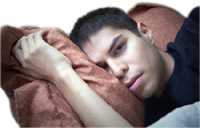4.2. Central nervous system adverse effects
 Very common and common adverse effects
Very common and common adverse effects
Headache can occur. SSRIs can be both stimulating and sedating and this effect will vary from patient to patient. Patients who are stimulated by SSRIs may suffer insomnia. SSRIs can also produce tremor and shaking, particularly at higher doses. Twitching may occur at night, especially of the legs. Grinding of teeth (bruxism) may also occur. More severe movement disorders, such as acute dystonic reactions1 and parkinsonism are rare. (Akathisia2 may develop and is covered under psychiatric adverse effects).
Factors which increase risk
Concomitant use of antidepressants with other psychotropic drugs3 such as antipsychotics and lithium increases the risk of CNS effects. Patients with lethargy should also be assessed for hyponatraemia.
The mechanism of SSRI-related movement disorders may involve serotonin-mediated inhibition of dopamine pathways. Such effects are more likely when an SSRI is taken with a dopamine receptor antagonist.
Risk-reduction measures
In instances of headache, clinicians should also ask about visual symptoms as SSRIs can blur vision (but this is not a common effect).
Tremors, shaking and profuse sweating may be a sign of excessive SSRI dose, calling for a review of the dose. The rare, but serious, serotonin syndrome should also be ruled out.
Treatment
CNS side effects may improve spontaneously within the first two weeks of treatment. The effects are often dose-related. If symptoms do not resolve spontaneously, then the dose should be reviewed and alternatives considered.
Reviewing the timing of the daily dose of SSRI as well as sleep hygiene may help with sleep disorders. Those who are stimulated by SSRIs and suffer insomnia are usually better on a morning dose of SSRI, while those who are sedated are usually better on an evening dose. Long-term use of hypnotics to aid sleep is not recommended and specialist advice should be sought where necessary.
- A movement disorder characterised by sustained muscle contractions, resulting in abnormal posturing or repetitive writhing movements.↩
- Sensation of restlessness and a compulsion to move constantly.↩
- A chemical substance which can alter brain function, resulting in changes in consciousness, cognition, perception, mood or behaviour.↩